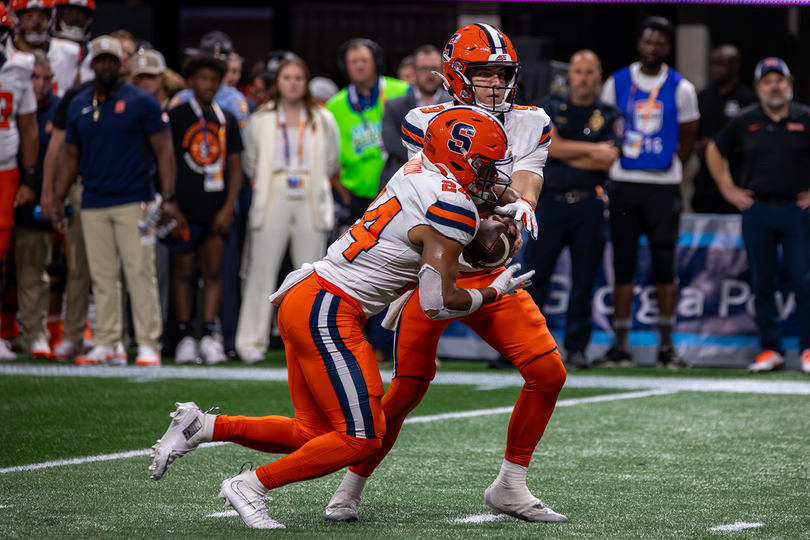Film Review: Rundown of Jeff Nixon’s backfield tweaks for Syracuse

Syracuse's running back room, headlined by Yasin Willis and Will Nixon, enjoyed success against Tennessee due to tweaks from offensive coordinator Jeff Nixon. Leonardo Eriman | Photo Editor
Get the latest Syracuse news delivered right to your inbox. Subscribe to our sports newsletter here.
When the Houston Texans requested to interview Jeff Nixon for their vacant offensive coordinator job last winter, Syracuse quickly made sure those types of opportunities weren’t enticing enough for him to leave.
In February, after the Texans passed on him, Nixon inked a multi-year contract extension as SU’s offensive coordinator. It was a no-brainer deal for the Orange, who boasted the nation’s No. 1 passing offense in 2024 — their first season with Nixon dialing up playcalls.
While SU primarily used an air-raid attack last year, Nixon made a name for himself with his creative and unpredictable scheme. He mixed in a ground-and-pound rushing attack for LeQuint Allen Jr. and deceiving play-action sets that Kyle McCord mastered.
Without Allen Jr., who was selected in the seventh round of the 2025 NFL Draft by the Jacksonville Jaguars, it naturally becomes harder for Nixon to bait opponents with play-action or lean on a heavy running game. Allen Jr. was one of the Atlantic Coast Conference’s most prolific running backs last year, picking up over 1,500 scrimmage yards. So, how would Nixon adjust?
Wielding a backfield group led by sophomore Yasin Willis and senior Will Nixon — Nixon’s son — the Orange’s offensive coordinator is varying up how he uses his rushers. Instead of one do-it-all dynamo in Allen Jr., Nixon is playing off Willis’ strength as a power back and Will’s strength as a speedy pass-catcher. Against Tennessee, Willis tallied 23 carries for 91 yards and three touchdowns, while Will Nixon had nine carries for 33 yards alongside 29 receiving yards.
Here’s a film breakdown of Nixon’s tweaks to Syracuse’s (0-1, 0-0 ACC) running game in its 45-26 season-opening loss to No. 24 Tennessee (1-0, 0-0 Southeastern Conference) last Saturday:
1st quarter, 12:46 — A father-son playcall
On Syracuse’s first offensive play of the season, Nixon showed off the shades of a spread attack that he uses when Will Nixon is on the field. The Orange lined up in a pistol formation, with quarterback Steve Angeli a few feet behind center Austin Collins and Will Nixon positioned behind Angeli. One receiver split left and two split right, while tight end Dan Villari lined up on the right.
It’s a formation fit for a versatile running back like Will Nixon. He’s a threat to bounce left or right and become a pass catcher, move up in the pocket and block for Angeli, or take a handoff. Here, Nixon uses downfield receiving threats like Darrell Gill Jr. and Justus Ross-Simmons as decoys, drawing the secondary toward them while Will Nixon catches the defense by surprise.
Angeli, on first-and-10 from SU’s 25-yard line, immediately faced an all-out blitz from Tennessee’s second level upon receiving Collins’ snap. At the same time, Nixon leaked out to the right side, still a few yards behind the line of scrimmage. Angeli took a couple of steps right with Volunteer defensive back Andre Turrentine charging toward him, and the quarterback got a screen pass off to Will Nixon just before Turrentine collided with him.
Most of Tennessee’s defense was caught either deep downfield or preoccupied with rushing Angeli, giving Will Nixon 20 yards of free green grass ahead for him to bolt through. He was brought down at the 46-yard line on a big hit, but he salvaged a gain of 21 yards.
By catering this play to his son’s strengths, Nixon successfully dialed up the Orange’s first chunk play of the year.
2nd quarter, 11:45 — Speed-option for 6
Part of how Nixon changed up Syracuse’s run game is through Angeli himself. McCord didn’t need to be mobile because of his passing proficiency, but Nixon rarely used McCord’s legs by design. It’s a different story with Angeli. He’s more nimble than McCord, a trait Nixon perfectly highlighted on the goal line for SU’s first touchdown of the year.
Early in the second quarter, with the Orange down 17-0, Nixon drew up a speed-option that forced Tennessee to view Angeli as a threat to score with his legs. The Volunteers ignored Willis, who darted out to the left side of the backfield.
On second-and-goal from the two-yard line, Nixon put Syracuse in 12-personnel — two tight ends (David Clement, Villari) lined up on the right side. Angeli was in the shotgun with Willis flanking him to the right. After the snap, Willis sprinted behind Angeli and out toward the left sideline. The quarterback tucked the ball as if he was going to run, drawing Tennessee linebacker Arion Carter to barrel toward him.
As soon as Carter committed to Angeli, the signal-caller flipped the ball into the awaiting arms of Willis, who had an open lane at the left pylon of the end zone. Willis gunned toward the pylon and narrowly beat Volunteers linebacker Jeremiah Telander to put six points on the board for SU.
Ross-Simmons’ textbook block on the line of scrimmage against Colton Hood helped pave the way for Willis’ score, but it was Angeli’s acting that created the opportunity.
2nd quarter, 10:02 — Willis bounces outside
Heading into this year, the question mark surrounding Willis was if he had enough speed to be comparable to Allen Jr. One game in, it’s clear he’s made significant strides to get faster. Willis is more than a power back; he boasts dangerous speed.
It’s something Nixon used sporadically against Tennessee, mostly keeping Willis’ carries in between the tackles. But if this second-and-5 play early in the second quarter shows you anything, it’s that the Orange should find more ways to get Willis running on the outside.
With SU down 24-7 on its own 41-yard line, Nixon ran his typical 11-personnel shotgun set with Willis lined up just behind Angeli to his left. Upon the snap, Willis stepped right and took the handoff from Angeli, initially positioning himself for a run up the gut. At the same time, Villari — who lined up outside the right tackle — cut inward and blocked Tennessee defensive lineman Tyree Weathersby coming around the left side.
Perfect blocks by right tackle Da’Metrius Weatherspoon, right guard Joe Cruz and Collins gave Willis a massive hole on the right side, and he charged through it. Once Willis hit the outside, he ran past a diving Joshua Josephs and steamrolled down the sideline. Carter cut him off but not before Willis picked up 11 yards. Willis’ instincts guided him to the hole that his offensive line opened, and his speed turned it into one of his bigger gains of the day.
4th quarter, 11:54 — Trusting Yasin’s speed
This play is another instance of Nixon trusting Willis’ speed. On second-and-goal from the one-yard line, Nixon drew up a play where all Willis needed to do was beat Tennessee’s second level in a foot race.
The Orange trailed 38-20 in the fourth quarter, and a touchdown would put them within striking distance for a possible comeback. Nixon put Syracuse in a 12-personnel shotgun set, with Willis to Angeli’s right, Clement and Villari lined up slightly behind the line on the right and Ross-Simmons adjacent to left tackle Trevion Mack on the line of scrimmage.
If you pause on the moment Angeli exchanges the handoff with Willis, you can see Syracuse’s nine remaining players create a brick wall between Willis and Tennessee’s second level by completely sealing off the Volunteers’ defensive line. Willis cut to the left and easily sprinted into the end zone, beating Tennessee defensive back Kaleb Beasley by a mile.
There were rare instances where SU’s offensive line sealed off Tennessee like they did on this play, which resulted in Willis’ third touchdown of the game. The better the Orange can block for Willis, the more options Nixon will have to showcase the running back’s speed on the outside.





